Following the 2022 FIFA World Cup in Qatar, Roberto Martinez decided to call time on his tenure with the Belgian national team, after Les Diables rouges were eliminated at the round of sixteen stage.
This began the search for a new manager to lead Belgium into what is likely a new generation, with the so-called “golden generation” all beginning to reach the end of their international careers.
After a rather protracted search, the Belgian FA decided on 37-year-old former Schalke, Spartak Moscow, and RB Leipzig boss Domenico Tedesco.
The Italian-born German was an intriguing choice by the Belgian FA, with this tactical analysis piece having a look at what Belgians should expect from their new national team boss, with his first match in charge on Friday the 24th of March against Sweden in UEFA Euro 2024 qualifying.
Preferred formations and style of play
During his most recent spell in charge of RB Leipzig in the Bundesliga, Tedesco opted to set his side up in a very aggressive 3-4-1-2 system, with this likely being what he opts to go with during his first two Euro qualifying matches against Sweden and Germany.
The German manager likes his sides to be on the front foot, looking to be a side who are very attack-minded.
Tedesco also looks for his sides to hold the majority of possession, with his RB Leipzig side averaging over 56% of the ball.
When looking closer at the attacking statistics during his recent spell in Leipzig, the underlying numbers show his philosophy of being an attack-minded coach.
His Leipzig side created 1.52 xG per 90 minutes, along with averaging 9.05 shots per 90 minutes as well.
Tedesco’s sides also like to play vertically whenever possible, with his Leipzig side having the second most progressive passes in the Bundesliga last season, their 2,876 trailing only Bayern Munich.
A look at Tedesco’s more in-depth attacking style of play will be profiled later in this tactical analysis, but in general, Belgian fans should look to see a side that will likely be more proactive going forward than they were in the past, which is good considering the attacking talent that Tedesco called up in this first window in charge.
Build up play
The first thing that we will look at is the style of build-up that Domenico Tedesco looks to implement in his sides.
As already mentioned, the German manager has preferred a 3-4-1-2 formation, so it would be likely that he sticks with this at least for the first two Euro qualifiers.
Being that he likes to hold the majority of possession, Tedesco wants his sides to build out from the back with the goalkeeper, but in a certain way with his back three system.
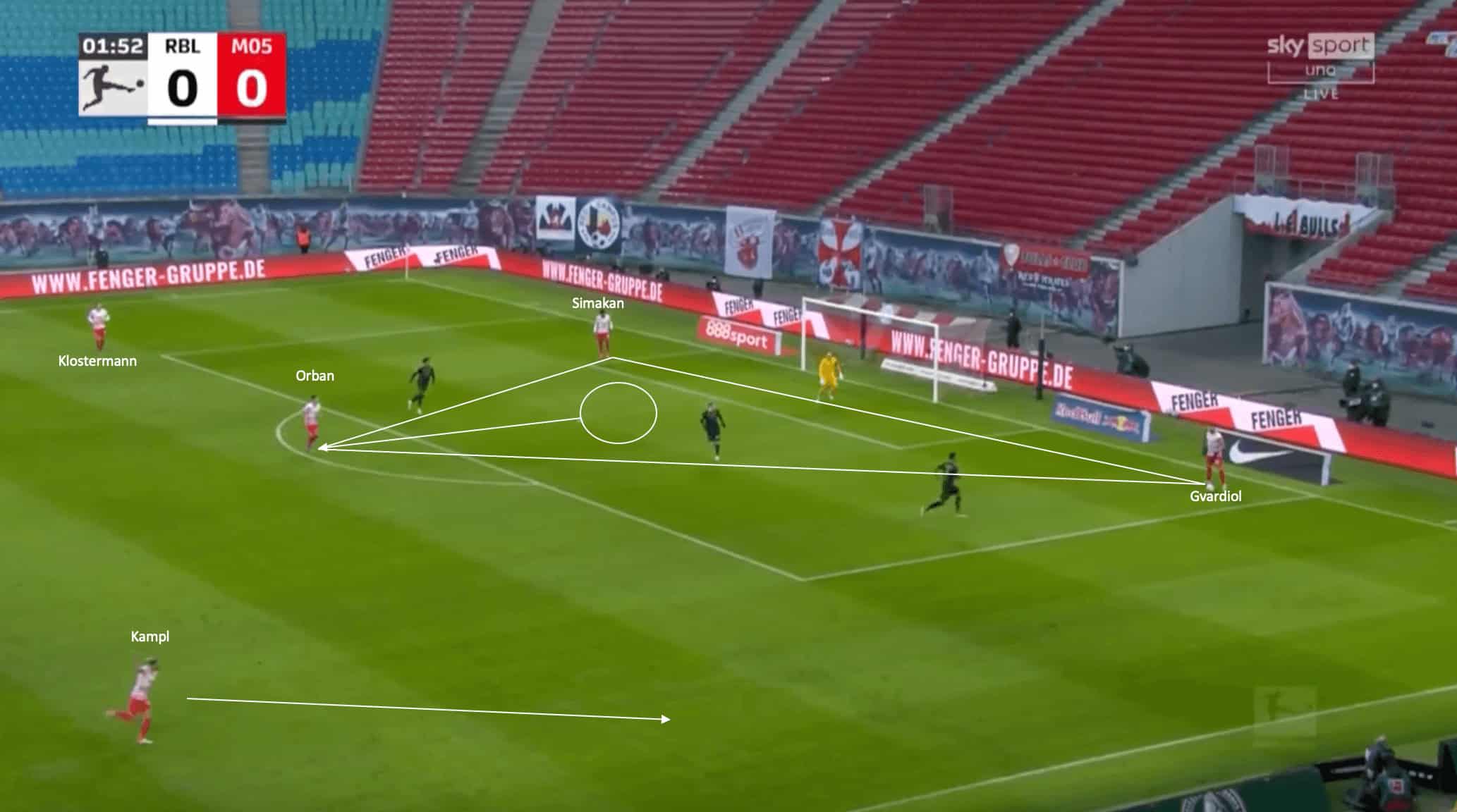
The image above shows an example of the typical shape Leipzig had during the build-up phase of play under Domenico Tedesco.
What Leipzig would look to do is create multiple passing options to escape the pressure from an opposition’s high press, or just more easily bypass opposition lines of pressure.
To counter this without having to necessarily play long is to attempt to create multiple passing options on the second line to break or bypass the opposition press, this being something that Tedesco implemented to great success with the Bundesliga side.
The first thing to notice is the shape of the back three.
The two wide centre-backs for Leipzig, Mohamed Simakan and Joško Gvardiol, stay wider, with goalkeeper Péter Gulácsi splitting the two.
The central centre-back, Willi Orban, pushes higher, which forces the opposition forwards to not press too high knowing the ball could be played to Orban to then turn and drive into the space in midfield, bypassing the press.
However, knowing that passing to Orban is a risky option, with the defender acting more like a decoy to bait the forwards into dropping off slightly, midfielder Kevin Kampl drops into a wing-back position, with him being a clear option for Gvardiol to pass to.
The other option is to play a cross-field ball to Lukas Klostermann on the far side or attempt to play Orban centrally.
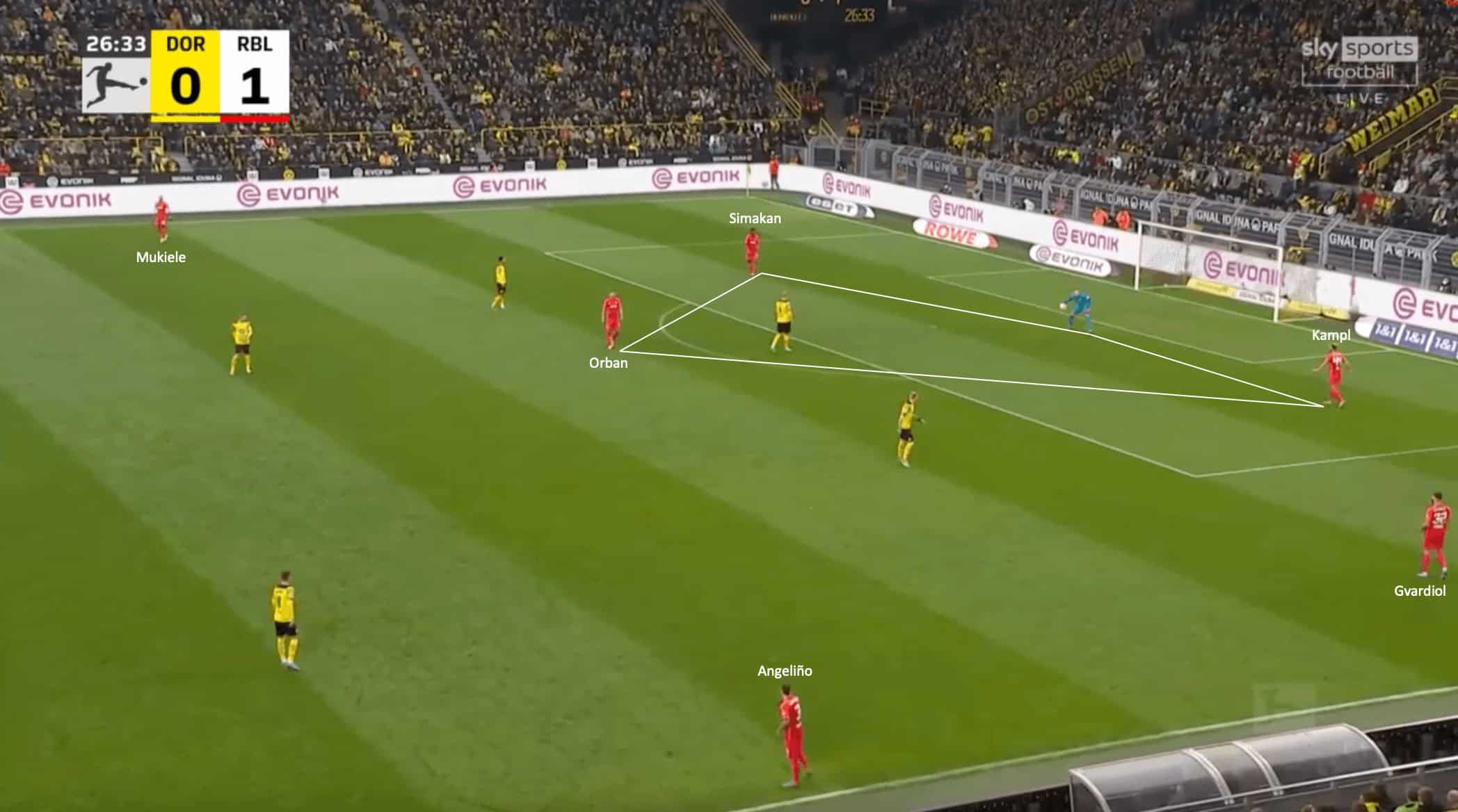
The image above shows another example of this shape utilised by Domenico Tedesco during the build-up phase.
The same almost diamond shape is present, with Willi Orban pushed up to prevent the Borussia Dortmund forwards from pressing too high and leaving Orban as a free option.
As mentioned previously, this allows the Leipzig players time in possession to play vertically, as an opposition high press would free the pass to Orban and break the opposition press with a single pass.
The difference here is that Kevin Kampl has dropped into the right centre-back position, with Gvardiol pushing well wide.
It is also interesting to note that both wing-backs, current PSG player Nordi Mukiele and Angeliño, are hugging the touchline while not being very advanced.
What this does is gives RB Leipzig a 6v5 numerical advantage in the defensive third of the pitch while also allowing them options to play the ball vertically to advanced positions.
This goes back to Tedesco’s philosophy of wanting to play a quick-flowing attacking brand of football, as opposed to consistently playing laterally or backward.
As this phase develops, the ball is rolled to Kampl who plays it wide to Gvardiol in this wide position.
With Angeliño occupying the player closest to him, it allows Gvardiol to play directly to the forward, bypassing the first two Dortmund lines and allowing Leipzig to continue progressing play in a more favourable position.
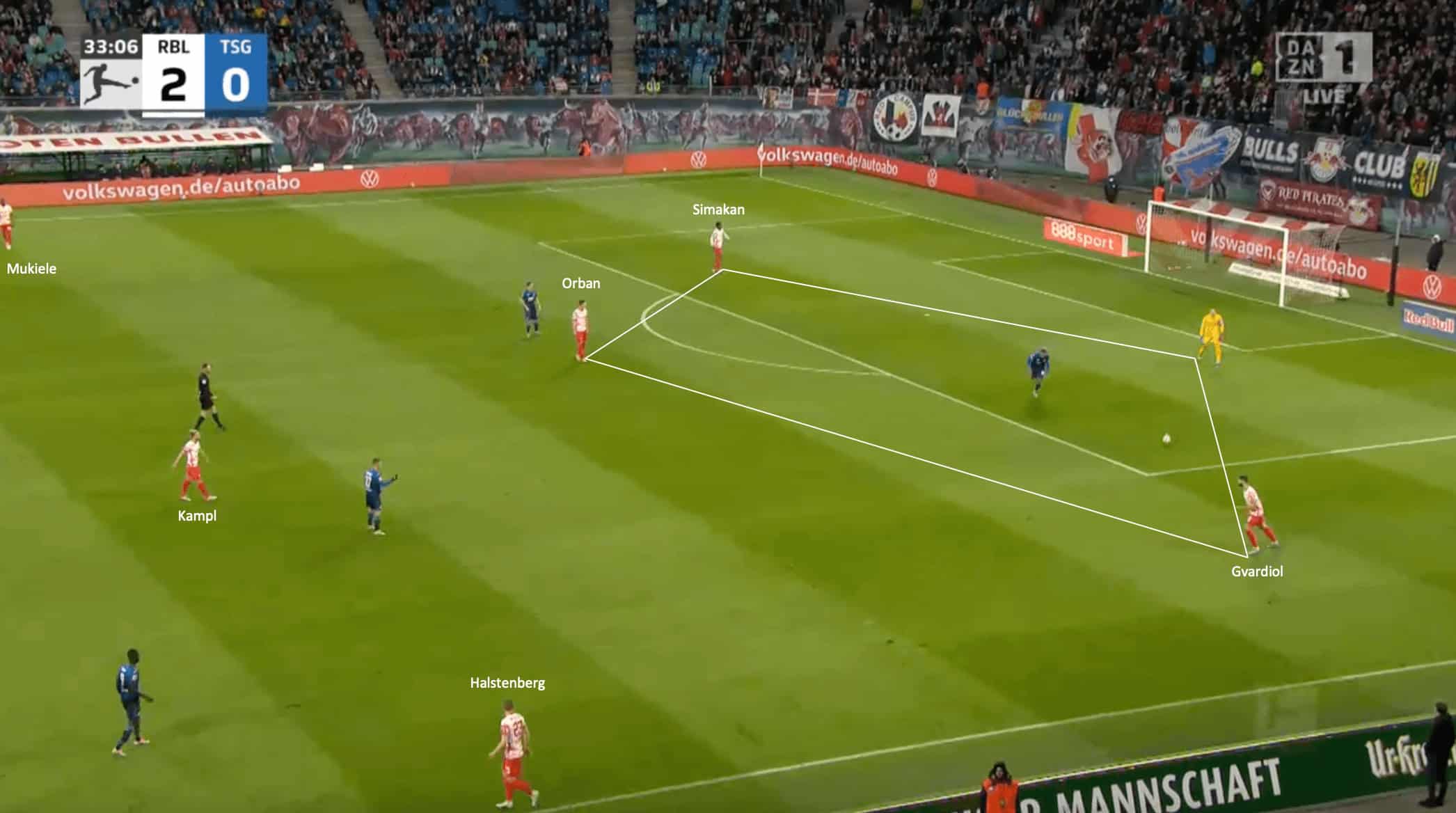
A final example of Tedesco’s style of build-up is shown above.
Once again, the diamond shape is prevalent, with Orban pushed high.
Both wing-backs are again positioned really wide, with Kampl again being the X-factor in this example.
The Slovenian international drops all the way to position himself between the goalkeeper and Gvardiol, which allows the Croatian international the time and space to receive the ball and play forward.
In the image, the ball is played to Gvardiol, but as the play progresses, Gulácsi again retains possession.
Kampl drops into the penalty box, which attracts the attention of the furthest advanced Hoffenheim forward.
This allows the Croatian to receive the ball and have time to scan for forward options.
This continuous off-the-ball movement keeps opposing pressing shapes questioning, as well as allowing Tedesco’s sides to create more than one option in an advanced possession to advance the ball vertically.
Attacking style of play
Tedesco is very much an attack-minded manager, with the attacking statistics of Leipzig during his time in charge indicative of this.
Last season, Leipzig finished with the second-most touches inside the penalty area (763) as well as the second-most touches in the penalty areas per 90 minutes (21.17).
What is rather interesting is the success rate of Tedesco’s Leipzig side when it came to crosses in the final third, with their 38.2% successful cross rate being the fourth-highest in the Bundesliga last season.
This is also considering that they were middle of the pack in the Bundesliga when it came to attempted crosses last season.
One of Tedesco’s attacking principles is to overload the wide areas during attacking phases, with a lot of his attacking tactics based on positional play and short passing distances, with players interchanging positions often and finding space in between opposition lines.
The manager also usually likes one of his outside centre-backs to push forward and join in attacking phases, with Joško Gvardiol normally doing this for him in Saxony.
This ability to create overloads in the wide channels allowed his side to have numerical advantages from an attacking perspective, allowing accurate crosses into the box, or plenty of touches inside the penalty area, as well as creating plenty of goal-scoring chances.
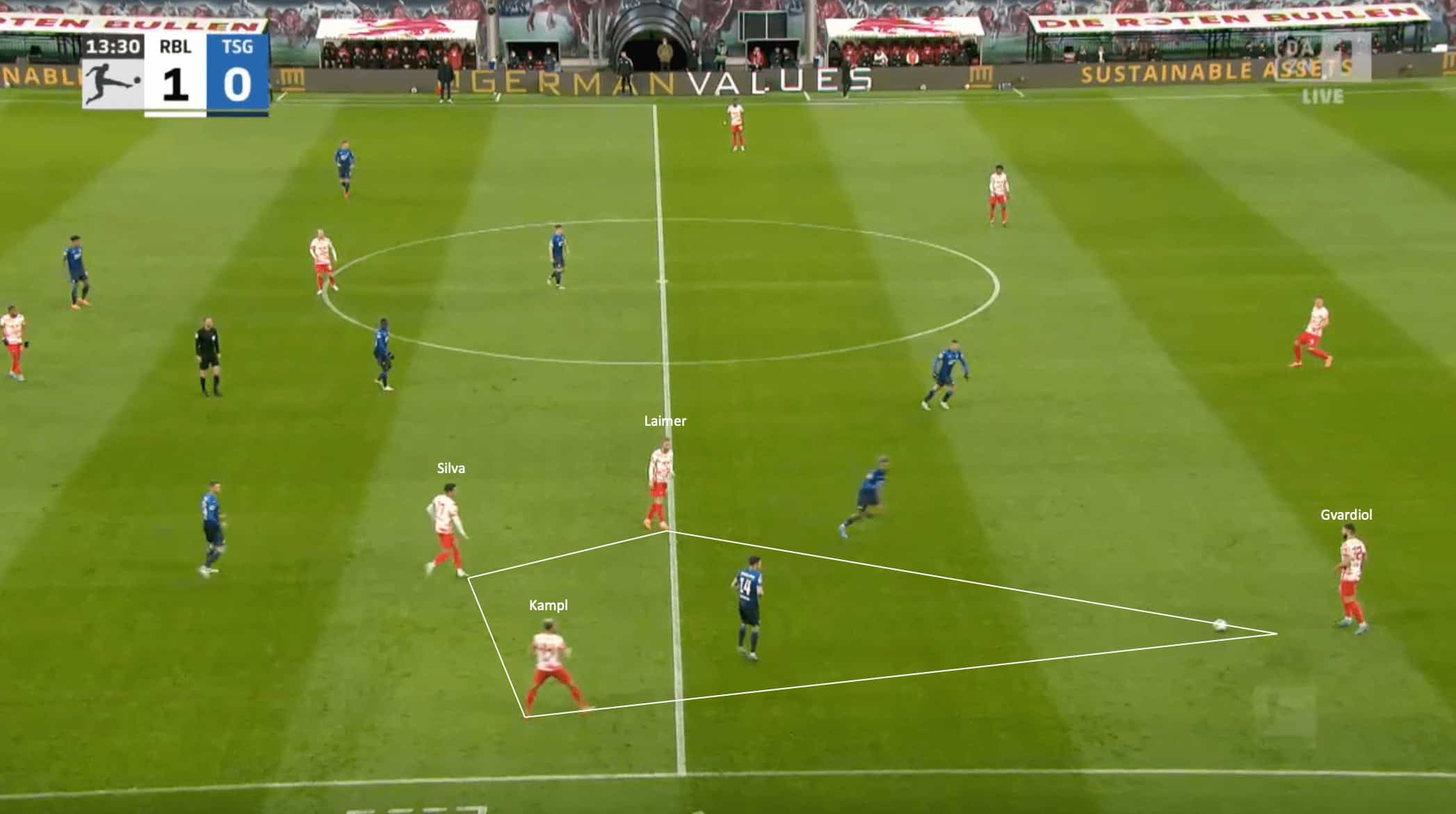
The image above shows an example of these attacking principles from Tedesco on display.
In this attacking phase of play for Leipzig against Hoffenheim, Tedesco’s side have overloaded the wide channel, with it being either a 4v2 or 4v3 against the defenders, whichever way you decide to look at it.
Similar to the build-up phase, they again create a diamond shape, with striker Andre Silva dropping between the lines into this half space.
As mentioned, the German manager looks for his sides to minimise distance during these attacking phases of play which allows short passing distances and as a result, less room for error when progressing the ball.
The positional movement is also important to note here.
With the wingback advanced and wide, he is able to pin the Hoffenheim defenders back, which allows Kampl to move into this wide position to help facilitate the overload.
While Leipzig are dispossessed in the end, with the number of players around the ball, they are able to quickly counter-press and eliminate any potential transition move from the opposition.
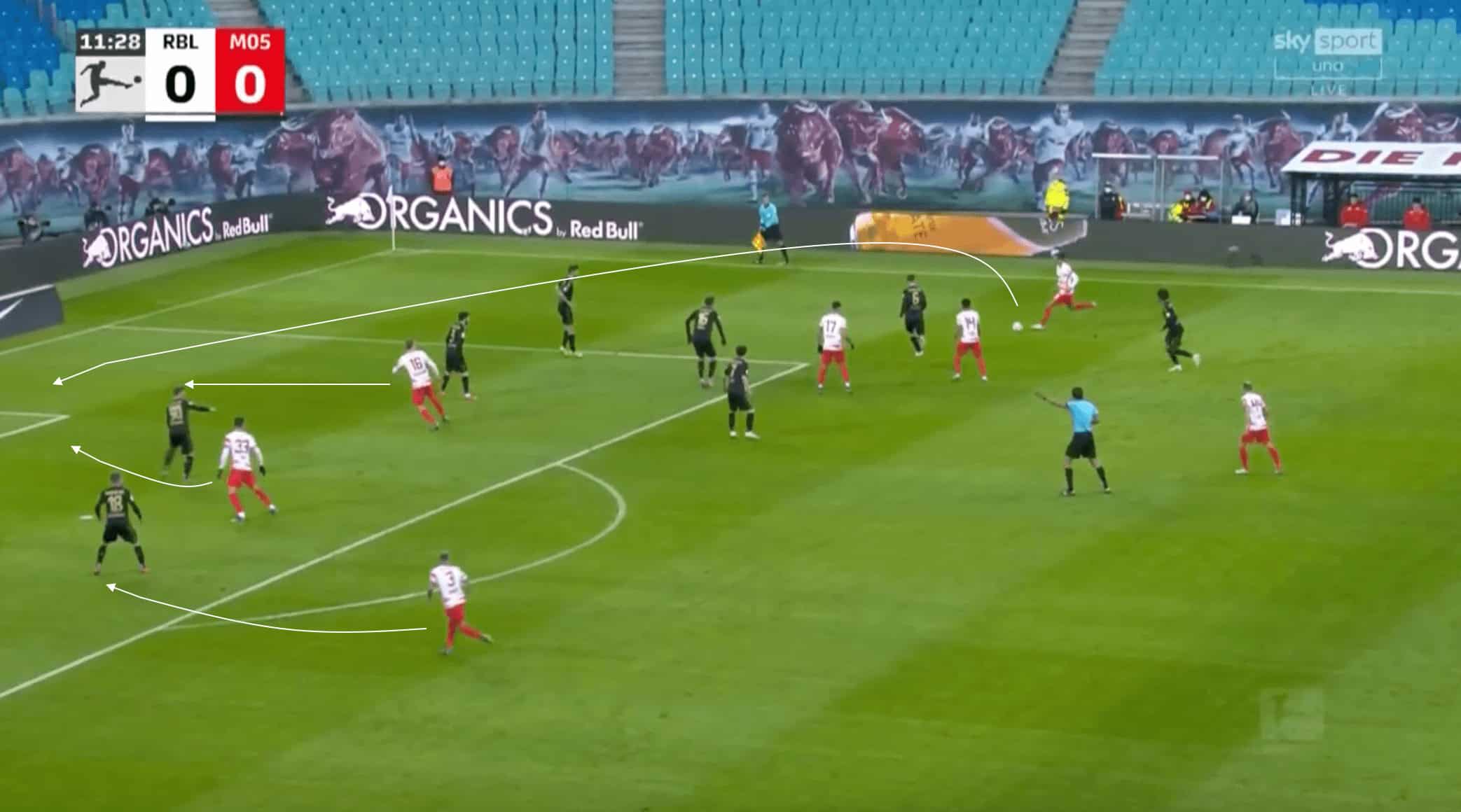
The image above shows a typical example of the types of runs that the Leipzig attackers made into the box last season when crosses were sent in from the wide areas.
What made the German side so successful with crossing accuracy under Tedesco was their layering of runs into the penalty box.
The example above is a very good illustration of this from a match against Mainz.
As the ball is played in from the wide channel, the three advanced Leipzig players in the penalty box layer their runs, which allows them multiple opportunities for them to create a chance.
So in this example, Lukas Klostermann is making the near post run, with Andre Silva behind him making the run centrally.
Klostermann makes his run early, which attracts the attention of the defender behind him.
Silva follows suit, with the ball able to find his head, with his ensuing shot sent just wide of the post.
It is also great to mention Angeliño at the back post, who holds off on his run just inside the penalty box.
The stopping of his run allows him a better angle to potentially receive a second ball, as opposed to him running too deep and the ball going out of play on the near side.
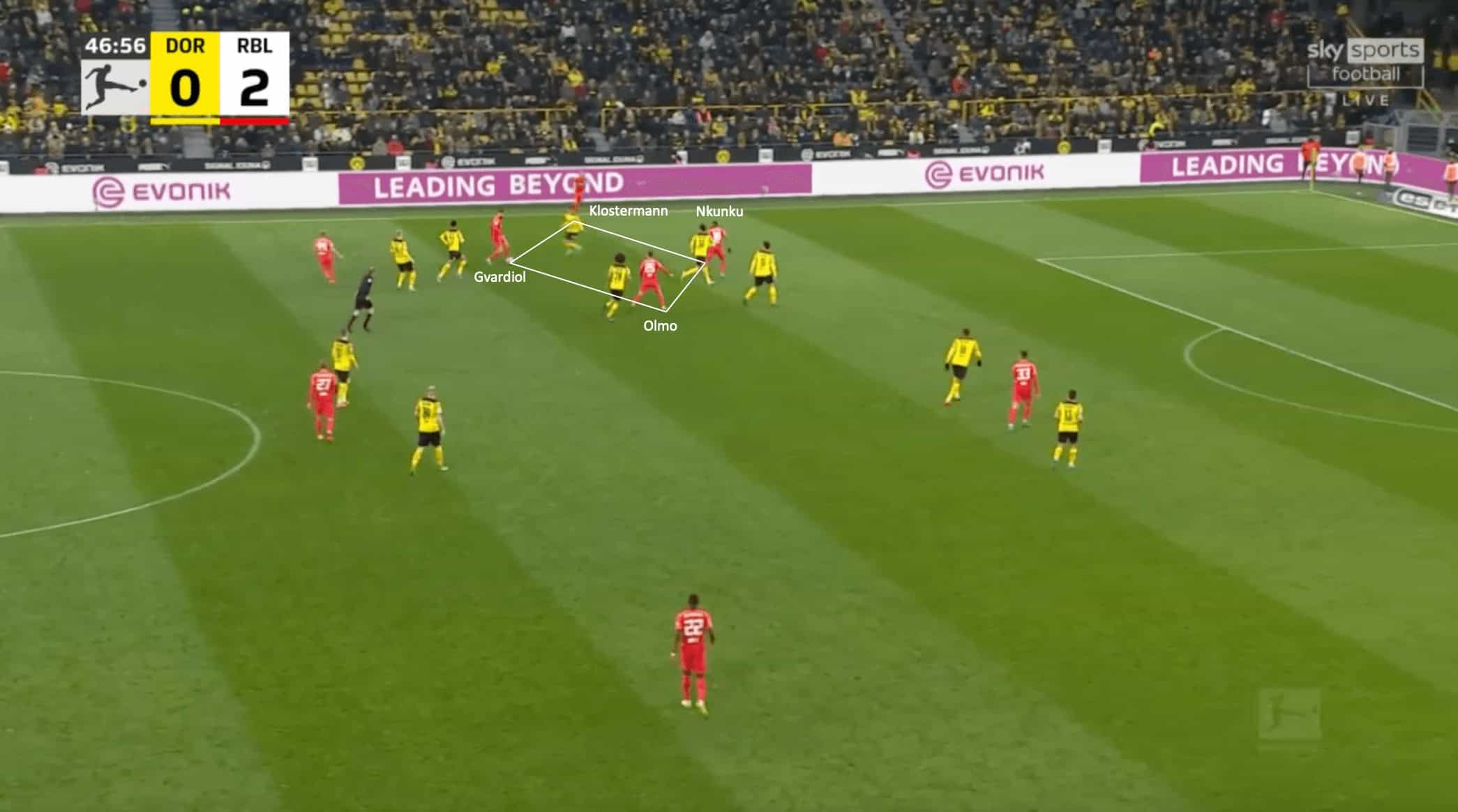
The image above again shows the impact of the centre-backs in Domenico Tedesco’s attacking phases to create overloads in the wide channels.
Against Dortmund, Gvardiol again progresses into an advanced area with the ball at his feet to create an overload.
While nothing results from this specific attacking phase, it still shows the impact the outside centre-backs have from an attacking aspect in Tedesco’s principles of attacking.
This is something that would be unsurprising to see with Belgium, along with the ability for runners into the box on crosses to consistently make contact as a result of creating layers in their runs and movements.
Defensive style of play
From a defensive standpoint, Tedesco likes to implement a counter-pressing style when possession is lost, but if they are forced to drop back into a defensive shape, it normally becomes a 5-3-2.
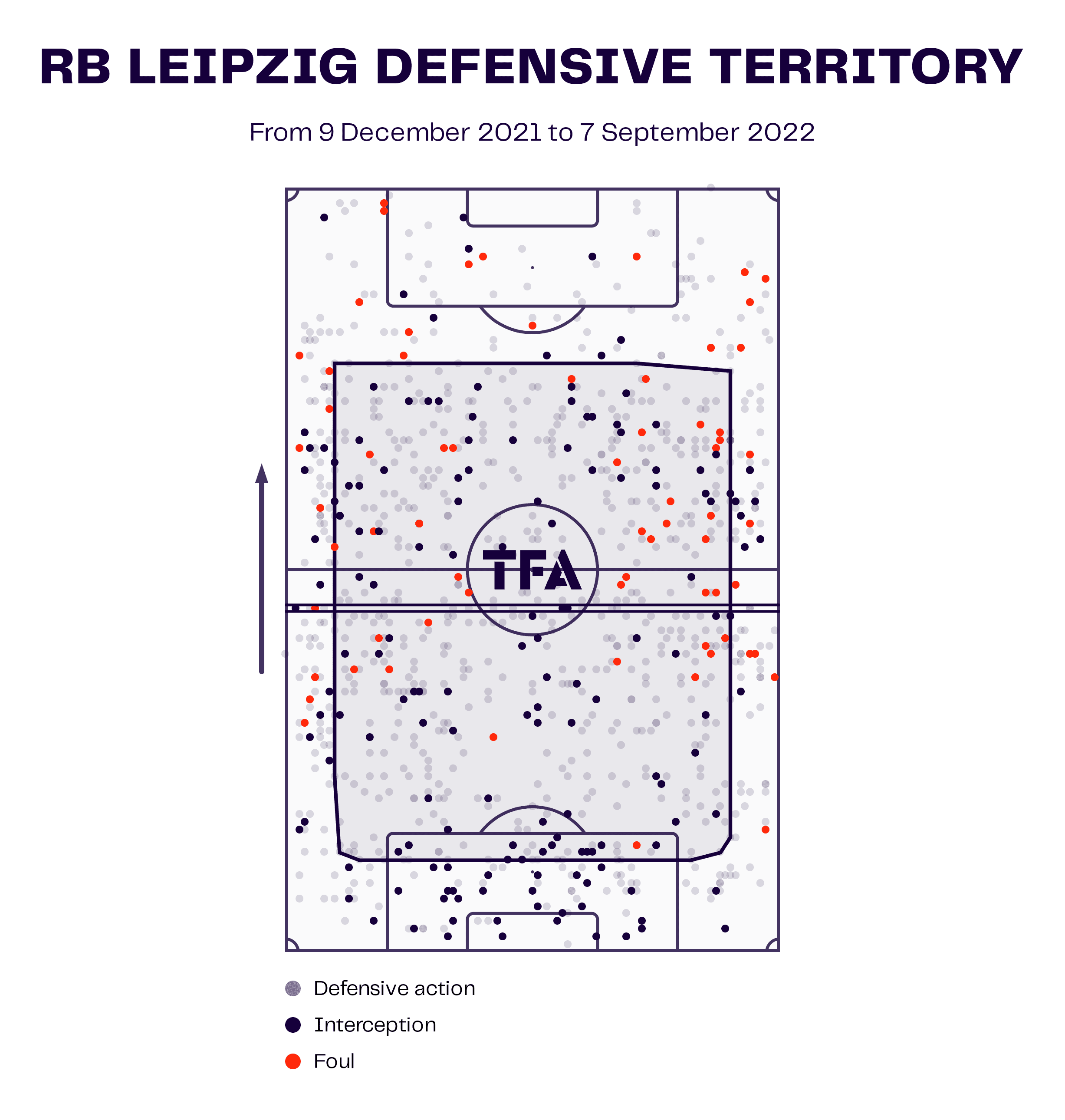
The data viz graphic above shows the average height of Leipzig’s defensive line from Tedesco’s time in charge.
As it illustrates, the average height of the defensive line was just inside their 18-yard box, but they also kept a high line defensively at times as well.
This 5-3-2 shape would also occasionally shift to a 5-2-1-2 as well, with normally Dani Olmo staying a bit further advanced in the defensive phases of play.
Also, at times, that shape would look like a 5-1-3-1, but could potentially look like a back four as well with one of the wing-backs tucking inside into midfield.
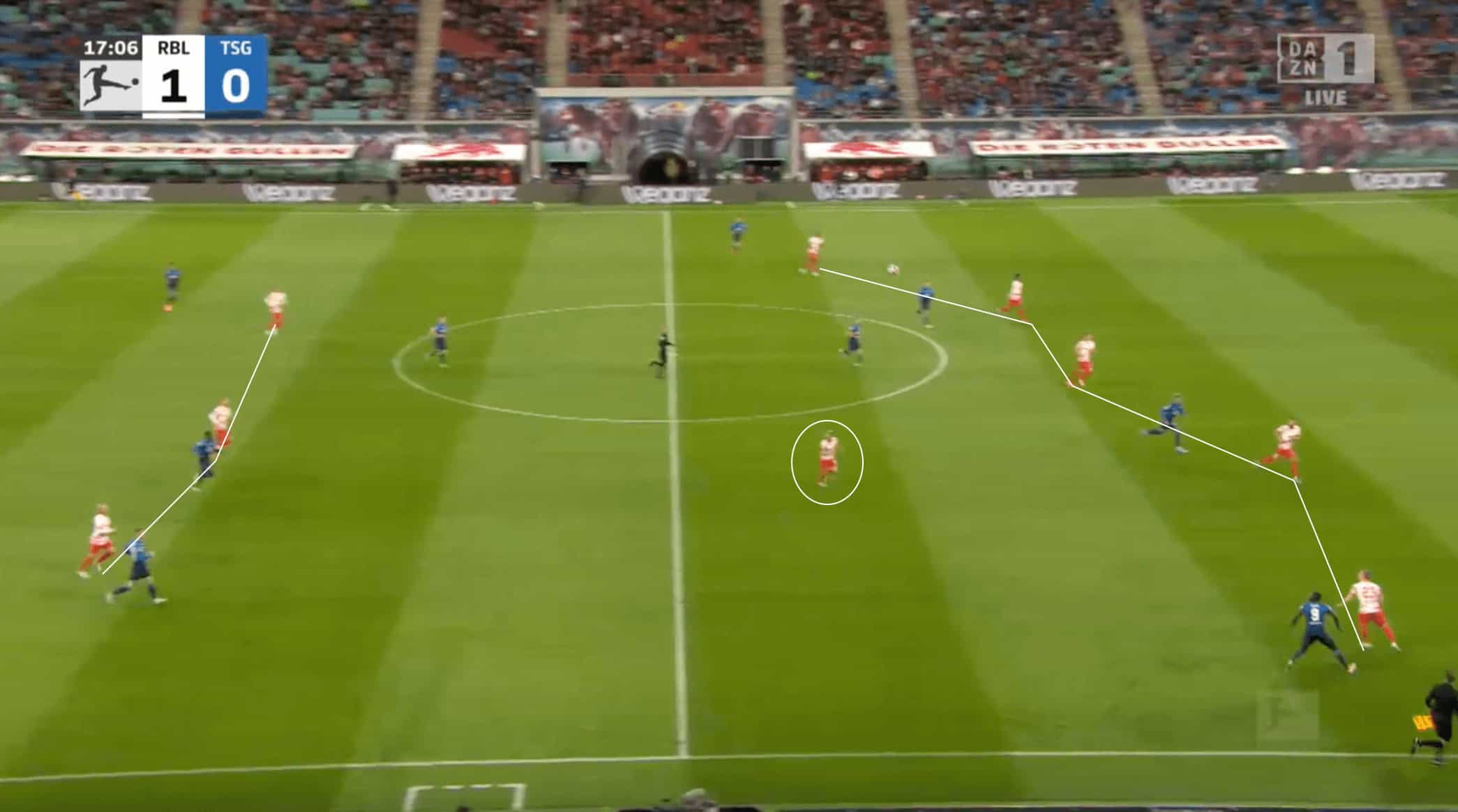
The image above shows an example of the defensive shape that Domenico Tedesco’s Leipzig had at times during his spell in charge.
The Italian-born German manager is not one known for his rock-solid defences, with his sides prone to leaking goals at the back.
The example above from the match against Hoffenheim shows Leipzig in a 5-1-3-1 shape defensively, one of the shapes they would opt for from a defensive standpoint.
In this phase of play, the opposition opted to play long from their goalkeeper, with the ball being won by the right-wing back over the Hoffenheim wide attacker.
Kevin Kampl’s positioning in this defensive phase is crucial to Leipzig winning second balls and regaining possession as a result.
In this system, the Slovenian midfielder is offered a free-roaming role, which allows him to move wherever he needs to be to find himself in an advantageous position to win the second ball.
This is what happens here, with the second ball falling to Kampl, allowing him to recover possession for Leipzig and start a transitional attacking moment.
In Tedesco’s first Belgian squad, it would be unsurprising to see someone like Everton’s Amadou Onana operate in a similar position to the one Kampl did for the German in Saxony, with Tedesco likely looking to find another Kampl-esque player for this system with Belgium.
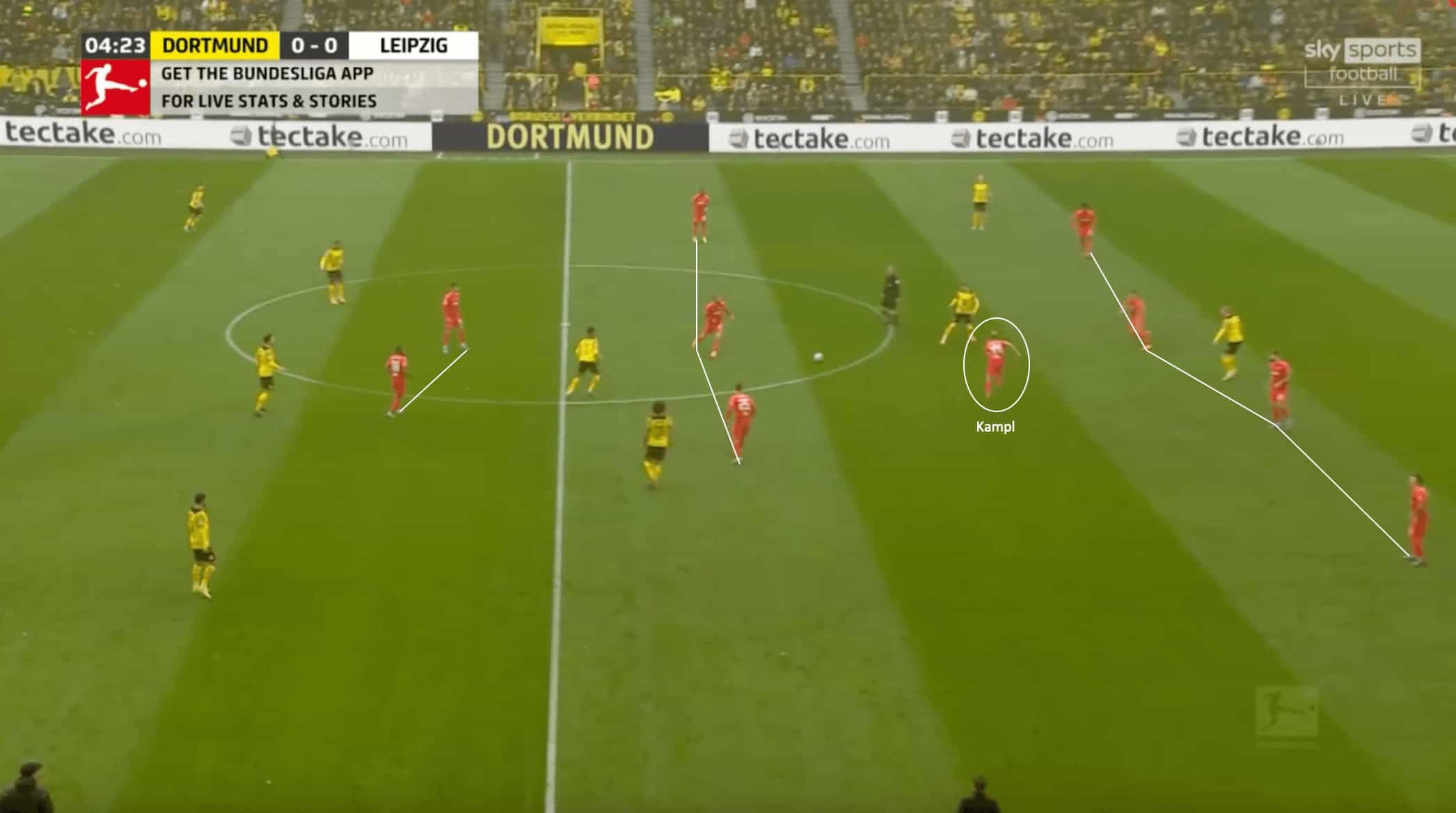
The image above shows another example of the defensive shape of Tedesco’s Leipzig side, with this time it being a 4-1-3-2.
While the formation has changed, one thing has remained constant, the single-pivot positioning of Kevin Kampl.
The midfielder was a massive cog in Tedesco’s defensive system at the club, and it would be unsurprising if another midfield player becomes key like Kampl was.
As already mentioned, this player would likely be Amadou Onana, with the likes of Kevin de Bruyne and Charles de Ketelaere playing in more advanced midfield positions.
This phase of play shown above is again impacted by the Slovenian, with him able to close down the Dortmund player receiving possession along with the centre-back who steps out of the defensive line.
All in all, Domenico Tedesco’s defensive style of play revolves around being able to cover space, with the German manager not one to sit in a defensive shell when his side are not in possession.
The role of a single-pivot midfielder also was crucial on the defensive side with Leipzig, so it would be likely these tactical trends transfer over to the Belgian national team.
Big emphasis on pressing
Another constant with the style of play of Domenico Tedesco is the emphasis he puts on pressing the opposition.
High pressing is relatively commonplace in German football, with Tedesco not being an exception to this.
Tedesco’s system needs to have attacking players who will look to constantly harass defenders when they are possessing the ball, looking to regain possession in advanced areas to then create chances.
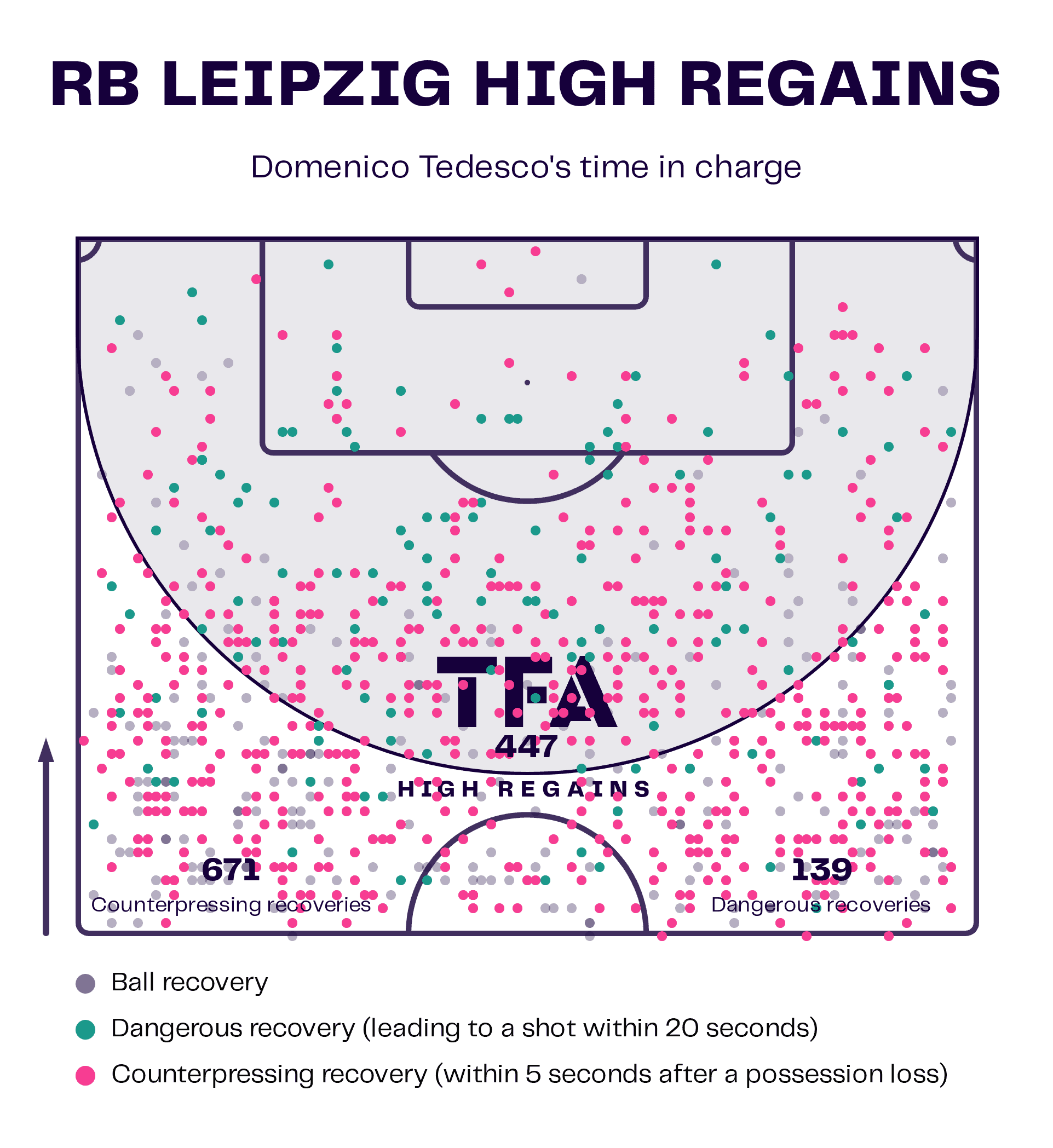
The data viz graphic above shows the amount of high regains, counter-pressing recoveries, and dangerous recoveries that RB Leipzig had during Domenico Tedesco’s spell in charge.
These numbers ranked near the top of the Bundesliga in these categories, with Leipzig consistently looking to pressure opposition defenders when they were in possession.
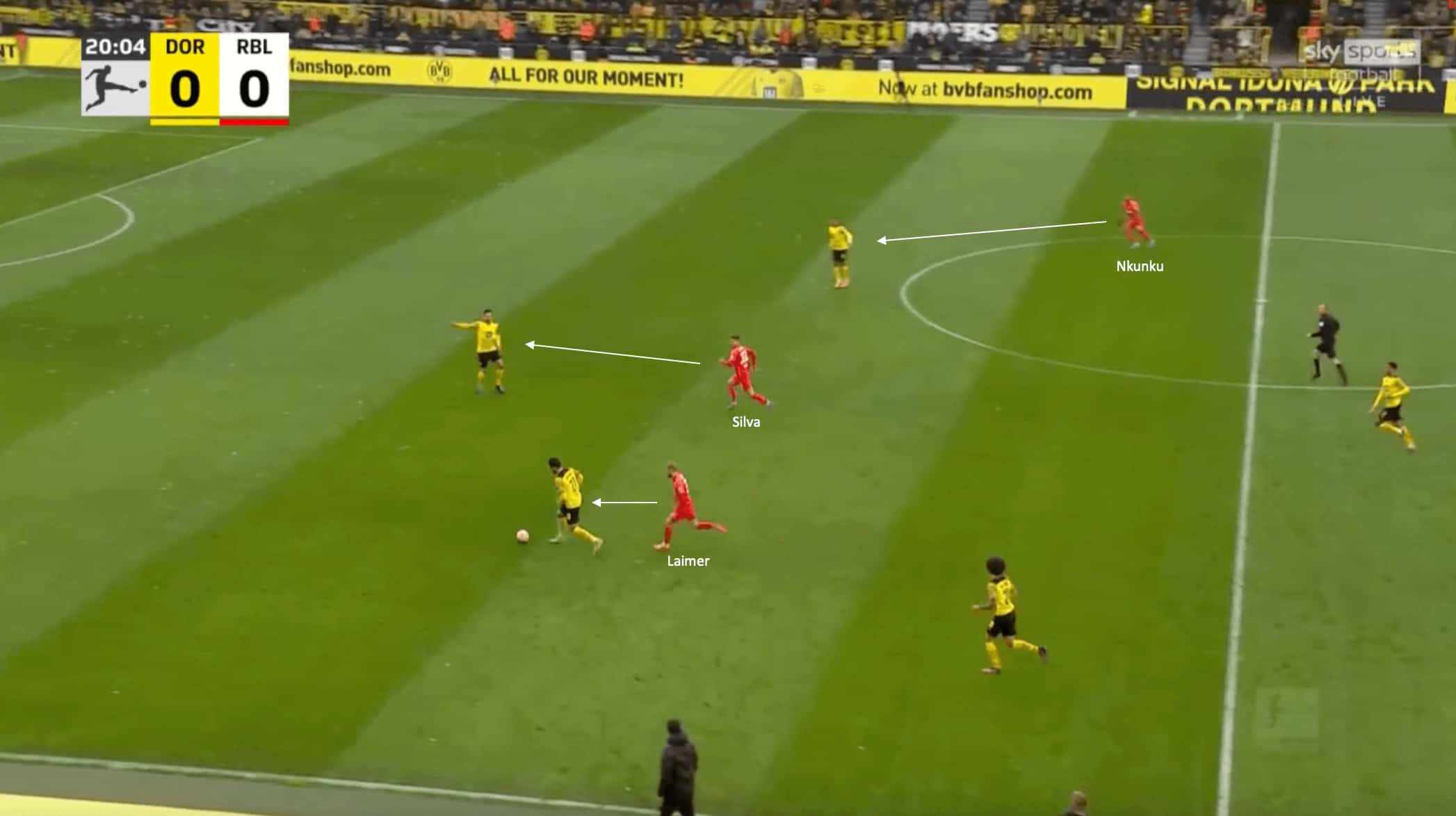
The image above shows an example of the type of pressing triggers that allow Tedesco’s sides to engage the opposition defenders when they are in possession.
In the phase of play above against Borussia Dortmund, the Dortmund fullback receives the ball from a more advanced position and turns with his back to the attack.
This triggers the Leipzig press, with Konrad Laimer getting advanced from his usual defensive midfield position to press the fullback.
Silva and Nkunku join him, with the two forwards closing down the space between them and the defenders to prevent a pass from going to them.
The only option is for the fullback to try and pass back to the goalkeeper but he is unable to, with Laimer pressuring him quickly enough to be able to dispossess him.
This pressing situation and turnover in an advanced area leads to a goal for Leipzig, with the Saxony side able to quickly play in behind the Dortmund defence and the ball eventually finding its way back to Laimer who is able to convert from close range.
This example shows how Tedesco likes his sides to strategically press, with them waiting for pressing triggers, as opposed to consistently trying to press high and becoming exposed defensively.
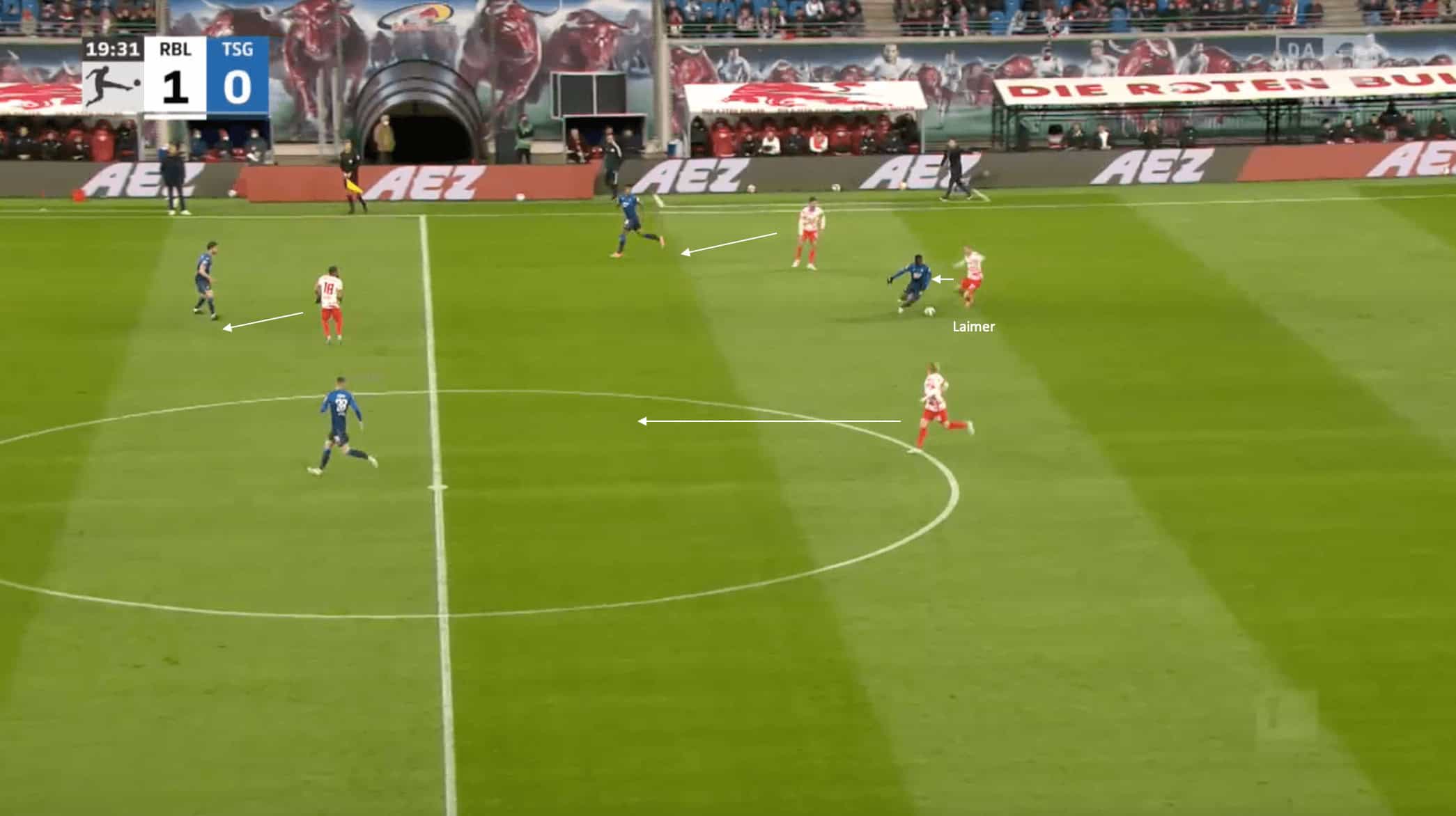
The image above shows another example of a Leipzig counter press that leads to a goal for the German side.
Similar to the first example shown, the Hoffenheim player receives possession and turns away from the pressure, looking to play the ball backwards.
However, the run of Emil Forsberg at the bottom prevents the pass from being played with it being too risky to be played into this space.
Instead, the forward decides to try and turn with the ball at his feet, but once again, Konrad Laimer is there to dispossess him.
This results in a quick transitional move by Leipzig, with the ball eventually finding the on-rushing Marcel Halstenberg at left wing-back who is able to coolly slot home.
As this section has shown, there will likely be elements of pressing to Domenico Tedesco’s Belgian side, but they will be based on certain triggers as opposed to an all-out anything-goes pressing system.
Another trend throughout this tactical analysis is that Domenico Tedesco relies heavily on his central midfield players as the basis of his style of play in all facets of the game, so the central players of his Belgium squad will be key to his success.
Conclusion
Domenico Tedesco was a rather interesting appointment in the eyes of some to lead the next generation of Belgian talent coming through the country.
However, as this tactical analysis has shown, it could be a very good fit for the way Belgian fans want their national team to play.
They don’t have long to wait, as Tedesco’s first match in charge against Sweden in Euro 2024 qualifying kicks off this Friday, before hosting Germany a few days later.
With this being Tedesco’s first foray into international management, it will be interesting to watch how his side does throughout the qualifiers, as well as how he transitions to the international game.





Comments